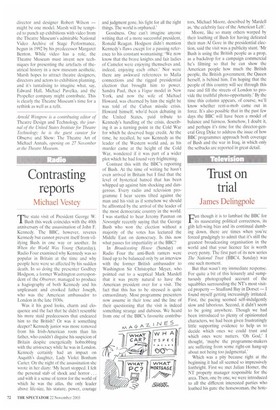Time for a rethink
Arnold Wengrow on the Theatre Museum's redevelopment plans
The Theatre Museum has hidden for 16 years in one of the most visible locations in London, a high-traffic corner of Covent Garden between the Theatre Royal, Drury Lane, and the Royal Opera House. Thousands pass it, all too literally, unaware that behind its Victorian exterior is one of the world's great collections of documents and art relating to the history of performance. No wonder Paul Webb complained in The Spectator in September 2001 that on a summer afternoon, while people thronged outside, only a handful were inside looking at the exhibitions.
In the early 1970s, Roy Strong, then director of the Victoria and Albert Museum, secured the basement of the former Flower Market building for the proposed Theatre Museum, a branch of the V&A. A location in Theatreland' must have seemed a good idea. But funding crises delayed the museum's approval until 1983. The current premises opened in 1987. By then London's theatre had centres of gravity away from the West End, and the most conspicuous theatre museum was becoming Shakespeare's Globe.
Even new, the Theatre Museum was dark and cramped. You are channelled down a narrow ramp into low-ceilinged black corridors with glass nooks, like cabinets of curiosities, showing relics that narrate the entire history of British theatre. Why does a museum about live performance feel like a catacomb?
The original installation has never been changed, despite new ideas and new technologies in museology. While there have been engaging temporary exhibitions, the uncongenial space imposes a similar design on them all. One temporary exhibition, on the National's The Wind in the Willows, is still in place after ten years. Whether through lack of funding, initiative, or imagination, the Theatre Museum has not flourished as a cultural attraction.
All that now may change. A new director, Geoffrey Marsh, arrived in April after working with Daniel Libeskind on the new Imperial War Museum North in Manchester, and has announced a £12 million redevelopment to double the current exhibition space. The architects Haworth Tompkins, responsible for the Royal Court redevelopment, will unblock windows to admit natural light and allow passers-by to see that something is indeed happening inside. They will tear out ramps, corridors and pillars, raise ceilings, and create a soaring entrance hall large enough to display one of the museum's treasures, the 10.3m x 11.7m drop curtain of Picasso's 'Le Train Bleu'. created for Diaghilev.
Marsh has to raise £12 million. Even if the majority comes from the Heritage Lottery Fund, he must lure the rest from trusts and corporations. A glamorous individual donor from the theatre would help.
Marsh wants more links with the theatrical profession and has made a good beginning with his first exhibition, A Great Night Out, on the making of the West End, supported by the Society of London Theatre, It is entertaining and unabashed propaganda for government funding for the historic commercial theatres but suffers from the 'cabinet of curiosities' syndrome. It's more about reading informative text panels or looking at well-produced videos than contemplating historically significant or visually compelling objects.
While he is raising funds, Marsh must ponder how performance history can be presented with both scholarly authority and popular panache. The Armani show at the Royal Academy — designed by opera director and designer Robert Wilson — might be one model. Marsh will be tempted to punch up exhibitions with video from the Theatre Museum's admirable National Video Archive of Stage Performance, begun in 1992 by his predecessor Margaret Benton. While video has a role, the Theatre Museum must invent new techniques for presenting the artefacts of theatrical history in a new museum aesthetic. Marsh hopes to attract theatre designers, directors and actors to exhibition planning, and it's tantalising to imagine what, say, Edward Hall, Michael Pavelka, and the Propeller company might contribute. This is clearly the Theatre Museum's time for a rethink as well as a refit.
Arnold Wengrow is a contributing editor of Theatre Design and Technology, the journal of the United States Institute for Theatre Technology; he is the guest curator for Observe and Show: The Theatre Art of Michael Annals, opening on 27 November at the Theatre Museum.



























































































 Previous page
Previous page